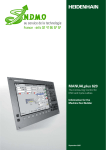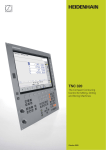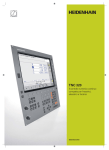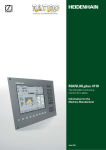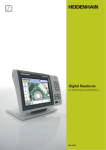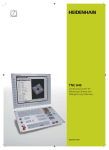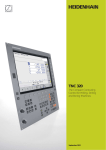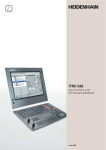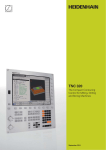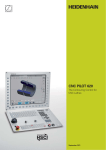Download Absolute Angle Encoders with Optimized Scanning
Transcript
Absolute Angle
Encoders
with Optimized Scanning
October 2010
Absolute Angle Encoders
with Optimized Scanning
The term angle encoder is typically used to
describe encoders that have an accuracy of
better than ± 5" and a line count above
10 000.
Angle encoders are found in applications
that require the highly accurate
measurement of angle in the range of a
few angular seconds, e.g. in rotary tables
and swivel heads on machine tools, C axes
on lathes, but also in measuring equipment
and telescopes.
This catalog describes absolute angle
encoders with optimized scanning. They
feature integral bearings, hollow shafts and
integrated stator couplings and are
distinguished in particular by:
• Small position error within one signal
period
• Large mounting tolerances
• High permissible shaft speeds
• Plug-in cables
• Functional Safety (option, in preparation)
You will find further incremental and
absolute angle encoders in the
corresponding product catalogs Angle
Encoders with Integral Bearing and Angle
Encoders without Integral Bearing.
In contrast, rotary encoders are used in
applications where accuracy requirements
are is less stringent, e.g. in automation, on
materials handling devices, electrical
drives, and many other applications.
Information on
• Angle encoders with integral bearing
• Angle encoders without integral bearing
• Rotary encoders
• Encoders for servo drives
• Exposed linear encoders
• Linear encoders for numerically
controlled machine tools
• HEIDENHAIN controls
is available on request as well as on the
Internet at www.heidenhain.de.
2
This catalog supersedes all previous
editions, which thereby become invalid.
The basis for ordering from HEIDENHAIN
is always the catalog edition valid when
the contract is made.
Standards (ISO, EN, etc.) apply only
where explicitly stated in the catalog.
Contents
Technical Features and Mounting Information
Advantages
4
Measuring Principles
5
Measuring Accuracy
6
Mechanical Design Types and Mounting
8
General Mechanical Information
Specifications
10
RCN 2000 Series
Hollow shaft
¬ 20 mm
12
RCN 5000 Series
¬ 35 mm
14
RCN 8000 Series
¬ 60 mm
16
¬ 100 mm
18
EnDat
20
Electrical Connection
Absolute Position Values
Cables and Connecting Elements
22
General Electrical Information
24
3
Advantages
Advantages of Angle Encoders with Optimized Scanning
Large mounting tolerances through
• Optimized integrated stator coupling
with improved torsional rigidity
• Revised shaft sealing for large axial and
radial movements between the rotor and
stator
Previous scanning principle
Single-field scanning
Position error [%] f
High signal quality thanks to optimized
scanning
• Only two graduation tracks (previously
up to 23 parallel graduation tracks)
• Absolute track with serial code structure
• Incremental track with single-field
scanning
• Relatively insensitive to contamination
thanks to a large scanning surface
• Scanning signals with high signal quality
through special optical filtering
• Significantly reduced position error
within one signal period
Angle [°]f
Position error within one signal period
(example: RCN 2580, 1% position deviation ƒ 0.8“)
RCN 5000: Large hollow shaft with
small mounting space
• Stator can be mounted to the same
mating dimensions as the RCN 2000
(110 mm flange diameter)
• Hollow shaft with ¬ 35 mm has more
than three times the cross section of the
RCN 2000
• More space for stiffer shafts or hydraulic
lines
• Reduced overall height of 42 mm for the
RCN 5000 instead of 55 mm for the
RCN 2000
Plug-in electrical connection enables
• Selectable lengths of connecting cable
through separately ordered cable
assemblies
• Simple connection through quick
disconnects (no tools required)
• High tightness level of IP 67
20 mm
35 mm
Large hollow shaft of RCN 5000
New scanning and evaluation
electronics for
• High shaft speeds up to 3 000 min–1 with
purely serial data transmission
• Increased power-supply range of 3.6 V to
14 V
• Encoder monitoring and diagnostics
without an additional line
Plug-in cable
4
Measuring Principles
Measuring standard
HEIDENHAIN encoders incorporate
measuring standards of periodic structures
known as graduations. These graduations
are applied to a glass or steel substrate.
Glass scales are used primarily in encoders
for speeds up to 10 000 min–1. For higher
speeds—up to 20 000 min–1—steel drums
are used. The scale substrate for large
diameters is a steel tape.
These precision graduations are
manufactured in various photolithographic
processes. Graduations are fabricated
from:
• extremely hard chromium lines on glass
or gold-plated steel drums,
• matte-etched lines on gold-plated steel
tape, or
• three-dimensional structures etched into
quartz glass.
Absolute measuring method
With the absolute measuring method, the
position value is available from the encoder
immediately upon switch-on and can be
called at any time by the subsequent
electronics. There is no need to move the
axes to find the reference position.
The absolute position information is read
from the graduated disk which is formed
from a serial absolute code structure. The
code structure is unique over one revolution.
A separate incremental track is read with
the single-field scanning principle and
interpolated for the position value.
These photolithographic manufacturing
processes—DIADUR, AURODUR or
METALLUR—developed by HEIDENHAIN
produce grating periods of:
• 40 µm with AURODUR
• 20 µm with METALLUR
• 10 µm with DIADUR
• 4 µm and less with etched silica glass
Photoelectric scanning
Most HEIDENHAIN encoders operate
using the principle of photoelectric
scanning. Photoelectric scanning of a
measuring standard is contact-free, and as
such, free of wear. This method detects
even very fine lines in the micrometer
range and less, and generates output
signals with very small signal periods.
The RCN angle encoders with integral
bearing operation according to the imaging
scanning principle.
Put simply, the imaging scanning principle
functions by means of projected-light
signal generation: two graduations with
equal or similar grating periods—the scale
and the scanning reticle—are moved
relative to each other. The scale carrier
material is steel. The graduation on the
measuring standard can likewise be
applied to a transparent surface, but
also a reflective surface.
When parallel light passes through a
grating, light and dark surfaces are
projected at a certain distance. An index
grating with the same or similar grating
period is located here. When the two
gratings move relative to each other, the
incident light is modulated. If the gaps in
the gratings are aligned, light passes
through. If the lines of one grating coincide
with the gaps of the other, no light passes
through. A large, finely structured
photosensor converts these variations in
light intensity into electrical signals. Its
structures have the same width as that of
the measuring standard. The special
structure filters the light current to
generate nearly sinusoidal output signals.
These processes permit very fine grating
periods and are characterized by a high
definition and homogeneity of the line
edges. Together with the photoelectric
scanning method, this high edge definition
is a precondition for the high quality of the
output signals.
The master graduations are manufactured
by HEIDENHAIN on custom-built highprecision ruling machines.
Light source
(LED)
Condenser
lens
Graduated
Disk
Incremental track
Absolute track
Structured
photosensor
Graduated disk with serial code track and incremental track
Single-field scanning principle
5
Measuring Accuracy
The accuracy of angular measurement is
mainly determined by
1. the quality of the graduation,
2. the quality of the scanning process,
3. the quality of the signal processing
electronics,
4. the eccentricity of the graduation to the
bearing,
5. the radial runout of the bearing,
6. the elasticity of the encoder shaft and
its coupling with the drive shaft,
7. and the elasticity of the stator coupling.
The total errors are ascertained at constant
temperature (22 °C) during the final
inspection and is recorded on the quality
inspection certificate.
Position error within one revolution
Position error f
Position error within one revolution
The system accuracy given in the
Specifications is defined as follows:
The extreme values of the total errors of
a position—with respect to their mean
value—are within the system accuracy ± a.
Position error within
one signal period
The system accuracy reflects position
errors within one revolution as well as
those within one signal period and—for
angle encoders with integral bearing and
integral stator coupling—the errors of the
shaft coupling.
Position f
HEIDENHAIN RCN angle encoders with
optimized scanning permit interpolation
of the sinusoidal output signals with
subdivision accuracies of better than
± 0.5 % of the signal period. The
reproducibility is even better, meaning
that useful electric subdivision factors
and small signal periods permit small
enough measuring steps.
6
Position error f
Position error u within one signal period
Signal level f
Position errors within one signal period
Position errors within one signal period
already become apparent in very small
angular motions and in repeated
measurements. They especially lead to
speed ripples in the speed control loop.
These errors within one signal period are
caused by the quality of the graduation and
its scanning. The smaller the signal period,
the smaller the errors.
Signal period
360 °elec.
For its angle encoders with integral
bearings, HEIDENHAIN prepares individual
quality inspection certificates and ships
them with the encoder. The quality
inspection certificate documents the
encoder’s accuracy and serves as a
traceability record to a calibration standard.
The system accuracy of angle encoders is
ascertained through five forward and five
backward measurements. The measuring
positions per revolution are chosen to
determine very exactly not only the longrange error, but also the position error
within one signal period.
The mean value curve shows the
arithmetic mean of the measured values,
in which the reversal error is not included.
The reversal error is ascertained with
forward and backward measurements at
ten positions. The maximum value and
arithmetic mean are documented on the
calibration chart.
The following limits apply to the reversal
error:
RCN 2xxx:
Max. 0.6“
RCN 5xxx:
Max. 0.6“
RCN 8xxx:
Max. 0.4“
The calibration standard is indicated in
order to certify the traceability to the
national standard.
Example
Determination of the reversal error with forward and backward measurements
Measuring point
Reference mark
7
Mechanical Design Types and Mounting
RCN
RCN angle encoders feature an integral
bearing, a hollow shaft and a stator
coupling. The measured shaft is directly
connected with the shaft of the angle
encoder.
Design
The graduated disk is rigidly affixed to the
hollow shaft. The scanning unit rides on the
shaft on ball bearings and is connected to
the housing with a coupling on the stator
side. The stator coupling and the sealing
design of the RCN with optimized scanning
greatly compensates axial and radial
mounting errors without restricting
function or accuracy. This permits relatively
large mounting tolerances to facilitate
mounting. During angular acceleration of
the shaft, the coupling must absorb only
that torque caused by friction in the
bearing. Angle encoders with integrated
stator coupling therefore provide excellent
dynamic performance.
Mounting
The RCN housing is firmly connected to
the stationary machine part with an integral
mounting flange and a centering collar.
Ring nut
Mounting aid
Shaft coupling with ring nut
The shaft of the RCN is designed as a
hollow through shaft. For installation, the
hollow through shaft of the angle encoder
is placed over the machine shaft, and is
fixed with a ring nut from the front of the
encoder. The ring nut can easily be
tightened with the mounting tool.
Front end shaft coupling
It is often helpful, especially with rotary
tables, to integrate the angle encoder in
the table so that it is freely accessible
when the rotor is lifted. The hollow shaft is
connected by threaded holes on the face
with the aid of special mounting elements
adapted to the respective design (not
included in delivery). To comply with radial
and axial runout specifications, the internal
bore 1 and the shoulder surface 2 are to
be used as mounting surfaces for shaft
coupling at the face of the encoder.
Mounting an angle encoder with hollow through shaft
Example of shaft connection at encoder face
8
Ring nuts for the RCN
HEIDENHAIN offers special ring nuts for
RCN angle encoders. Choose the tolerance
of the shaft thread such that the ring nut
can be tightened easily, with a minor axial
play. This guarantees that the load is evenly
distributed on the shaft connection, and
prevents distortion of the encoder’s hollow
shaft.
Ring nut for
RCN 200
Series
*) Pitch diameter
Ring nut for
RCN 5000 series
*) Pitch diameter
Ring nut for the RCN 2xxx
Hollow shaft ¬ 20 mm: ID 336 669-03
Ring nut for the RCN 5xxx
Hollow shaft ¬ 35 mm: ID 336 669-17
D2 *)
Ring nut for the RCN 8xxx
Hollow shaft ¬ 60 mm: ID 336 669-11
Hollow shaft ¬ 100 mm: ID 336 669-16
Mounting tool for HEIDENHAIN ring
nuts
The mounting tool is used to tighten the
ring nut. Its pins lock into the bore holes in
the ring nuts. A torque wrench provides
the necessary tightening torque.
Mounting tool for ring nuts with
Hollow shaft ¬ 20 mm
ID 530 334-03
Hollow shaft ¬ 35 mm
ID 530 334-17
Hollow shaft ¬ 60 mm
ID 530 334-11
Hollow shaft ¬ 100 mm
ID 530 334-16
PWW inspection tool for angle encoders
The PWW makes a simple and quick
inspection of the most significant mating
dimensions possible. The integrated
measuring equipment measures position
and radial runout regardless of the type of
shaft coupling, for example.
PWW for
Hollow shaft 20 mm:
Hollow shaft 35 mm:
Hollow shaft 60 mm:
Hollow shaft 100 mm:
Ring nut
for
L1
L2
D1
D2
D3
B
Hollow shaft
¬ 35
¬ 46±0.2
¬ 40
(¬ 34.052
±0.075)
¬ 34.463
±0.053
(¬ 35.24)
1
Hollow shaft
¬ 60
¬ 70±0.2
¬ 65
(¬ 59.052
±0.075)
¬ 59.469
±0.059
(¬ 60.06)
1
Hollow shaft
¬ 100
¬ 114±0.2
¬ 107
(¬ 98.538
±0.095)
(¬ 99.163
±0.07)
(¬ 100.067)
1.5
ID 516 211-01
ID 516 211-06
ID 516 211-03
ID 516 211-05
9
General Mechanical Information
Degree of protection
Unless otherwise indicated, all RCN angle
encoders meet protection standard IP 67
according to IEC 60529 or EN 60529. This
includes housings and cable outlets. The
shaft inlet provides protection to IP 64.
Splash water should not contain any
substances that would have harmful
effects on the encoder parts. If the
protection to IP 64 of the shaft inlet is not
sufficient (such as when the angle encoder
is mounted vertically), additional labyrinth
seals should be provided.
For this purpose, HEIDENHAIN offers the
DA 300 compressed air unit (filter
combination with pressure regulator and
fittings). The compressed air introduced
into the DA 300 must fulfill the
requirements of the following quality
classes as per ISO 8573-1 (2001 edition):
• Max. particle size and density of solid
contaminants:
Class 4 (max. particle size: 15 µm, max.
particle density: 8 mg/m3)
• Total oil content:
Class 4 (oil content 5 mg/m3)
• Maximum pressure dew point:
No class (+29 °C at 10 · 105 Pa)
The following components are necessary
for connection to the RCN angle encoders:
M5 connecting piece for RCN
With gasket and throttle ¬ 0.3 mm
For air-flow rate from 1 to 4 l/min
ID 207835-04
M5 coupling joint, swiveling
with seal
ID 207834-02
RCN angle encoders are equipped with a
compressed air inlet. Connection to a
source of compressed air slightly above
atmospheric pressure provides additional
protection against contamination.
The compressed air introduced directly
onto the encoders must be cleaned by a
microfilter, and must comply with the
following quality classes as per ISO 8573-1
(2001 edition):
• Solid contaminants: Class 1
(max. particle size 0.1 µm and max.
particle density 0.1 mg/m3 at 1 · 105 Pa)
• Total oil content: Class 1
(max. oil concentration 0.01 mg/m3
at 1 · 105 Pa)
• Maximum pressure dew point: Class 4,
but with reference conditions of
+3 °C at 2 · 105 Pa
DA 300
For more information, ask for our DA 300
Product Information sheet.
10
Temperature range
The angle encoders encoders are
inspected at a reference temperature of
22 °C. The system accuracy given in the
calibration chart applies at this temperature.
The operating temperature range
indicates the ambient temperature limits
between which the angle encoders will
function properly.
The storage temperature range of –30 °C
to 70 °C applies when the unit remains in
its packaging.
Protection against contact
After encoder installation, all rotating parts
(clamping rings) must be protected against
accidental contact during operation.
Acceleration
Angle encoders are subject to various
types of acceleration during operation and
mounting.
• Permissible angular acceleration for
angle encoders:
– RCN 2000 series: 15 000 rad/s2
– RCN 5000 series: 10 000 rad/s2
– RCN 8000 series: 3 000 rad/s2
• The indicated maximum values for
vibration are valid according to
EN 60 068-2-6.
• The maximum permissible acceleration
values (semi-sinusoidal shock) for shock
and impact are valid for 6 ms (EN
60 068-2-27). Under no circumstances
should a hammer or similar implement
be used to adjust or position the
encoder.
Natural frequency fN of coupling
Together, the stator and stator coupling of
RCN angle encoders form a single vibrating
spring-mass system.
The natural frequency fN should be as
high as possible. The frequency ranges
given in the respective specifications are
those where the natural frequencies of the
encoders do not cause any significant
position deviations in the measuring
direction.
If radial and/or axial acceleration occurs
during operation, the effect of the rigidity of
the encoder bearing, the encoder stator
and the coupling are also significant. If
such loads occur in your application,
HEIDENHAIN recommends consulting
with the main facility in Traunreut.
Expendable parts
HEIDENHAIN encoders contain
components that are subject to wear,
depending on the application and handling.
These include in particular the following
parts:
• LED light source
• Cables with frequent flexing
Additionally for encoders with integral
bearing:
• Bearing
• Shaft sealing rings for rotary and angular
encoders
• Sealing lips for sealed linear encoders
System tests
Encoders from HEIDENHAIN are usually
integrated as components in larger
systems. Such applications require
comprehensive tests of the entire
system regardless of the specifications
of the encoder.
The specifications given in the brochure
apply to the specific encoder, not to the
complete system. Any operation of the
encoder outside of the specified range
or for any other than the intended
applications is at the user’s own risk.
In safety-related systems, the higherlevel system must verify the position
value of the encoder after switch-on.
Mounting
Work steps to be performed and
dimensions to be maintained during
mounting are specified solely in the
mounting instructions supplied with the
unit. All data in this catalog regarding
mounting are therefore provisional and
not binding; they do not become terms
of a contract.
11
RCN 2000 Series
• Integrated stator coupling
• Hollow through shaft ¬ 20 mm
• System accuracy ± 2.5“ and ± 5“
A
k
À
Á
Â
d
12
=
=
=
=
=
=
Bearing of mating shaft
Required mating dimensions
Mark for 0° position ± 5°
Free space for customer
Cable support
Compressed air inlet
Direction of shaft rotation for output signals as per the interface description
Absolute
RCN 2510
RCN 2310
RCN 2580
Measuring standard
Line count
DIADUR circular scale with absolute and incremental track
16 384
System accuracy
± 2.5“
± 5“
± 2.5“
Position error per signal
period
† ± 0.3“
† ± 0.4“
† ± 0.4“
Absolute position values
EnDat 2.2
Ordering designation
EnDat 22
Positions per revolution
268 435 456 (28 bits)
Elec. permissible speed
† 3 000 min
Clock frequency
† 16 MHz
Calculation time tcal
† 5 µs (at 8 MHz clock frequency)
Incremental signals
–
» 1 VPP
Cutoff frequency –3 dB
–
‡ 400 kHz
Electrical connection
Separate adapter cable connectable to encoder via quick disconnect
Power supply
DC 3.6 to 14 V
Power consumption1)
(maximum)
3.6 V: † 1.1 W
14 V: † 1.4 W
Current consumption
(typical)
5 V: † 225 mA (without load)
Shaft
Hollow through shaft D = 20 mm
Mech. permissible speed
–1
–1 2)
† 1 500 min ; temporary: † 3 000 min
Starting torque
† 0.08 Nm at 20 °C
Moment of inertia of rotor
188 · 10–6 kgm2
Permissible axial motion
of measured shaft
± 0.3 mm
Natural frequency
‡ 1 000 Hz
Vibration 55 to 2 000 Hz
Shock 6 ms
2
† 200 m/s (EN 60 068-2-6)
† 1 000 m/s2 (EN 60 068-2-27)
Operating temperature
RCN 25xx: 0 °C to 50 °C
RCN 23xx: –20 °C to 60 °C
Protection EN 60 529
IP 64
Weight
Approx. 1.0 kg
1)
2)
RCN 2380
± 5“
EnDat 02
–1
67 108 864 (26 bits)
for continuous position value
268 435 456 (28 bits)
67 108 864 (26 bits)
† 1 500 min–1 for continuous position value
† 2 MHz
See General Electrical Information
Speeds over 1 500 min–1 require consultation
13
RCN 5000 Series
• Integrated stator coupling
• Hollow through shaft ¬ 35 mm
• System accuracy ± 2.5“ and ± 5“
A
k
À
Á
Â
d
14
=
=
=
=
=
=
Bearing of mating shaft
Required mating dimensions
Mark for 0° position ± 5°
Free space for customer
Cable support
Compressed air inlet
Direction of shaft rotation for output signals as per the interface description
Absolute
RCN 5510
RCN 5310
RCN 5580
Measuring standard
Line count
DIADUR circular scale with absolute and incremental track
16 384
System accuracy
± 2.5“
± 5“
± 2.5“
Position error per signal
period
† ± 0.3“
† ± 0.4“
† ± 0.4“
Absolute position values
EnDat 2.2
Ordering designation
EnDat 22
Positions per revolution
268 435 456 (28 bits)
Elec. permissible speed
† 3 000 min
Clock frequency
† 16 MHz
Calculation time tcal
† 5 µs (at 8 MHz clock frequency)
Incremental signals
–
» 1 VPP
Cutoff frequency –3 dB
–
‡ 400 kHz
Electrical connection
Separate adapter cable connectable to encoder via quick disconnect
Power supply
DC 3.6 to 14 V
Power consumption1)
(maximum)
3.6 V: † 1.1 W
14 V: † 1.4 W
Current consumption
(typical)
5 V: † 225 mA (without load)
Shaft
Hollow through shaft D = 35 mm
Mech. permissible speed
–1
–1 2)
† 1 500 min ; temporary: † 3 000 min
Starting torque
† 0.08 Nm at 20 °C
Moment of inertia of rotor
140 · 10–6 kgm2
Permissible axial motion
of measured shaft
± 0.3 mm
Natural frequency
‡ 1 000 Hz
Vibration 55 to 2 000 Hz
Shock 6 ms
2
† 200 m/s (EN 60 068-2-6)
† 1 000 m/s2 (EN 60 068-2-27)
Operating temperature
RCN 55xx: 0 °C to 50 °C
RCN 53xx: –20 °C to 60 °C
Protection EN 60 529
IP 64
Weight
Approx. 0.9 kg
1)
2)
RCN 5380
± 5“
EnDat 02
–1
67 108 864 (26 bits)
for continuous position value
268 435 456 (28 bits)
67 108 864 (26 bits)
† 1 500 min–1 for continuous position value
† 2 MHz
See General Electrical Information
Speeds over 1 500 min–1 require consultation
15
RCN 8000 Series
• Integrated stator coupling
• Hollow through shaft ¬ 60 mm
• System accuracy ± 1“ and ± 2“
A
k
À
Á
Â
Ã
d
16
=
=
=
=
=
=
=
Bearing of mating shaft
Required mating dimensions
Mark for 0° position ± 5°
Shown rotated by 45°
Cable support
Free space for customer
Compressed air inlet
Direction of shaft rotation for output signals as per the interface description
Absolute
RCN 8510
RCN 8310
RCN 8580
Measuring standard
Line count
DIADUR circular scale with absolute and incremental track
32 768
System accuracy
± 1“
± 2“
± 1“
Position error per signal
period
† ± 0.15“
† ± 0.2“
† ± 0.2“
Absolute position values
EnDat 2.2
Ordering designation
EnDat 22
Positions per revolution
536 870 912 (29 bits)
Elec. permissible speed
† 1 500 min
Clock frequency
† 16 MHz
Calculation time tcal
† 5 µs (at 8 MHz clock frequency)
Incremental signals
–
» 1 VPP
Cutoff frequency –3 dB
–
‡ 400 kHz
Electrical connection
Separate adapter cable connectable to encoder via quick disconnect
Power supply
DC 3.6 to 14 V
Power consumption1)
(maximum)
3.6 V: † 1.1 W
14 V: † 1.4 W
Current consumption
(typical)
5 V: † 225 mA (without load)
Shaft
Hollow through shaft D = 60 mm
Mech. permissible speed
–1
–1 2)
† 500 min ; temporary: † 1 500 min
Starting torque
† 0.7 Nm at 20 °C
Moment of inertia of rotor
1.3 · 10–6 kgm2
Permissible axial motion
of measured shaft
± 0.3 mm
Natural frequency
‡ 900 Hz
Vibration 55 to 2 000 Hz
Shock 6 ms
2
† 200 m/s (EN 60 068-2-6)
† 1 000 m/s2 (EN 60 068-2-27)
Operating temperature
0 °C to 50 °C
Protection EN 60 529
IP 64
Weight
Approx. 2.8 kg
1)
2)
RCN 8380
± 2“
EnDat 02
–1
for continuous position value
† 750 min–1 for continuous position value
† 2 MHz
See General Electrical Information
Speeds over 500 min–1 require consultation
17
RCN 8000 Series
• Integrated stator coupling
• Hollow through shaft ¬ 100 mm
• System accuracy ± 1“ and ± 2“
A
k
À
Á
Â
Ã
d
18
=
=
=
=
=
=
=
Bearing of mating shaft
Required mating dimensions
Mark for 0° position ± 5°
Shown rotated by 45°
Cable support
Free space for customer
Compressed air inlet
Direction of shaft rotation for output signals as per the interface description
Absolute
RCN 8510
RCN 8310
RCN 8580
RCN 8380
Measuring standard
Line count
DIADUR circular scale with absolute and incremental track
32 768
System accuracy
± 1“
± 2“
± 1“
Position error per signal
period
† ± 0.15“
† ± 0.2“
† ± 0.2“
Absolute position values
EnDat 2.2
Ordering designation
EnDat 22
Positions per revolution
536 870 912 (29 bits)
Elec. permissible speed
† 1 500 min–1 for continuous position value
† 750 min–1 for continuous position value
Clock frequency
† 16 MHz
† 2 MHz
Calculation time tcal
† 5 µs (at 8 MHz clock frequency)
Incremental signals
–
» 1 VPP
Cutoff frequency –3 dB
–
‡ 400 kHz
Electrical connection
Separate adapter cable connectable to encoder via quick disconnect
Power supply
DC 3.6 to 14 V
Power consumption1)
(maximum)
3.6 V: † 1.1 W
14 V: † 1.4 W
Current consumption
(typical)
5 V: † 225 mA (without load)
Shaft
Hollow through shaft D = 100 mm
Mech. permissible speed
–1
–1 2)
† 500 min ; temporary: † 1 500 min
Starting torque
† 1.5 Nm at 20 °C
Moment of inertia of rotor
3.3 · 10–6 kgm2
Permissible axial motion
of measured shaft
± 0.3 mm
Natural frequency
‡ 900 Hz
Vibration 55 to 2 000 Hz
Shock 6 ms
2
† 200 m/s (EN 60 068-2-6)
† 1 000 m/s2 (EN 60 068-2-27)
Operating temperature
0 °C to 50 °C
Protection EN 60 529
IP 64
Weight
Approx. 2.6 kg
1)
2)
± 2“
EnDat 02
See General Electrical Information
Speeds over 500 min–1 require consultation
19
Interfaces
Absolute Position Values
For more information, refer to the EnDat
Technical Information sheet or visit
www.endat.de.
Position values can be transmitted with or
without additional information (e.g. position
value 2, temperature sensors, diagnostics,
limit position signals). Besides the position,
additional information can be interrogated
in the closed loop and functions can be
performed with the EnDat 2.2 interface.
Parameters are saved in various memory
areas, e.g.:
• Encoder-specific information
• Information of the OEM (e.g. “electronic
ID label” of the motor)
• Operating parameters (datum shift,
instructions, etc.)
• Operating status (alarm or warning
messages)
Interface
EnDat serial bidirectional
Data transfer
Absolute position values, parameters and additional information
Data input
Differential line receiver according to EIA standard RS 485 for the
signals CLOCK, CLOCK, DATA and DATA
Data output
Differential line driver according to EIA standard RS 485 for the
signals DATA and DATA
Position values
Ascending during traverse in direction of arrow (see dimensions
of the encoders)
Incremental signals
» 1 VPP (see Incremental Signals 1 VPP) depending on the unit
Ordering
designation
Command set
Incremental
signals
Power supply
EnDat 01
EnDat 2.1
or EnDat 2.2
With
See specifications
of the encoder
EnDat 21
Without
EnDat 02
EnDat 2.2
With
EnDat 22
EnDat 2.2
Without
Versions of the EnDat interface (bold print indicates standard versions)
Absolute encoder
» 1 VPP A*)
Absolute
position value
Operating
parameters
Operating
status
» 1 VPP B*)
*) Depends on
encoder
Parameters of the encoder
Parameters manufacturer for
of the OEM
EnDat 2.1
EnDat 2.2
Cable length [m] f
Clock frequency and cable length
The clock frequency is variable—depending
on the cable length—between 100 kHz
and 2 MHz. With propagation-delay
compensation in the subsequent
electronics, clock frequencies up to
16 MHz at cable lengths up to 100 m
are possible.
Subsequent electronics
Incremental
signals *)
Monitoring and diagnostic functions of
the EnDat interface make a detailed
inspection of the encoder possible.
• Error messages
• Warnings
• Online diagnostics based on valuation
numbers (EnDat 2.2)
Incremental signals
EnDat encoders are available with or
without incremental signals. EnDat 21 and
EnDat 22 encoders feature a high internal
resolution. An evaluation of the incremental
signal is therefore unnecessary.
Expanded range
3.6 to 5.25 V
or 14 V
EnDat interface
The EnDat interface is a digital,
bidirectional interface for encoders. It is
capable both of transmitting position
values as well as transmitting or updating
information stored in the encoder, or saving
new information. Thanks to the serial
transmission method, only four signal
lines are required. The data is transmitted
in synchronism with the clock signal from
the subsequent electronics. The type of
transmission (position values, parameters,
diagnostics, etc.) is selected through mode
commands that the subsequent
electronics send to the encoder. Some
functions are available only with EnDat 2.2
mode commands.
300
2 000
4 000
8 000
12 000
16 000
Clock frequency [kHz]f
EnDat 2.1; EnDat 2.2 without propagation-delay compensation
EnDat 2.2 with propagation-delay compensation
20
Input Circuitry of the
Subsequent Electronics
Encoder
Data transfer
Subsequent electronics
Dimensioning
IC1 = RS 485 differential line receiver and
driver
C3 = 330 pF
Z0 = 120 −
Incremental signals
depending on
encoder
For a description of the 1 VPP
incremental signals see catalog: Angle
Encoders with Integral Bearing.
1 VPP
Pin layout
8-pin M12 coupling
Power supply
Absolute position values
8
2
5
1
3
4
7
6
UP
Sensor UP
0V
Sensor 0 V
DATA
DATA
CLOCK
CLOCK
Brown/Green
Blue
White/Green
White
Gray
Pink
Violet
Yellow
15-pin D-sub connector
For HEIDENHAIN controls and IK 220
17-pin M23 coupling
1)
Power supply
Absolute position values
Incremental signals
7
1
10
4
11
15
16
12
13
14
17
8
9
1
9
2
11
13
3
4
6
7
5
8
14
15
UP
Sensor
UP
0V
A+
A–
B+
B–
DATA
DATA
Brown/
Green
Blue
White/
Green
Green/
Black
Yellow/
Black
Blue/
Black
Red/
Black
Gray
Pink
Sensor Internal
0V
shield
White
/
CLOCK CLOCK
Violet
Yellow
Cable shield connected to housing; UP = power supply voltage
Sensor: The sensor line is connected in the encoder with the corresponding power line.
Vacant pins or wires must not be used!
1)
Only with ordering designations EnDat 01 and EnDat 02
21
Cables and Connecting Elements
General Information
Connector (insulated): A connecting
element with a coupling ring. Available
with male or female contacts.
Coupling insulated:
Connecting element with external thread;
available with male or female contacts.
Symbols
Symbols
M12
M23
M12
M23
Mounted coupling
with central fastening
Cutout for mounting
Mounted coupling
with flange
M23
M23
Flange socket: Permanently mounted
on the encoder or a housing, with
external thread (like a coupling), available
with male or female contacts.
Symbols
M23
D-sub connector: For HEIDENHAIN
controls, counters and IK absolute value
cards.
Symbols
The pins on connectors are numbered in
the direction opposite to those on
couplings or flange sockets, regardless of
whether the connecting elements are
With integrated interpolation
electronics
22
Bell seal
ID 266 526-01
male contacts or
female contacts.
1)
Accessories for flange sockets and
M23 mounted couplings
When engaged, the connections provide
protection to IP 67. (D-sub connector:
IP 50; EN 60529). When not engaged,
there is no protection.
Threaded metal dust cap
ID 219 926-01
EnDat Connecting Cables
8-pin
M12
17-pin
M23
EnDat without
incremental signals
EnDat with
incremental signals
PUR adapter cable
Complete
with 17-pin M23 coupling (male)
¬ 6 mm
–
ID 643 450-xx
Complete
with 15-pin D-sub connector (female)
¬ 4.5 mm
¬ 6 mm
ID 735 987-xx
–
–
ID 727 658-xx
Complete
with 8-pin M12 coupling (male)
¬ 4.5 mm
ID 679 671-xx
–
PUR connecting cables
2
2
8-pin: [(4 × 0.14 mm ) + (4 × 0.34 mm )] ¬ 6 mm
17-pin: [(4 × 0.14 mm2) + 4(2 × 0.14 mm2) + (4 × 0.5 mm2)] ¬ 8 mm
Complete with connector (female) and
coupling (male)
ID 368 330-xx
ID 323 897-xx
Complete with connector (female) and
D-sub connector (female) for IK 220
ID 533 627-xx
ID 332 115-xx
Complete with connector (female) and
D-sub connector (male) for IK 115/IK 215
ID 524 599-xx
ID 324 544-xx
With one connector (female)
ID 634 265-xx
ID 309 778-xx
Cable without connectors, ¬ 8 mm
–
ID 266 306-01
Mating element on connecting cable
to connector on encoder cable
Connector (female) for cable
¬ 8 mm
–
ID 291 697-26
Connector on connecting cable for
connection to subsequent electronics
Connector (male) for cable
¬ 8 mm
¬ 6 mm
–
ID 291 697-27
Coupling on connecting cable
Coupling (male) for cable
¬ 4.5 mm
¬ 6 mm
¬ 8 mm
–
ID 291 698-25
ID 291 698-26
ID 291 698-27
Flange socket for mounting on
subsequent electronics
Flange socket (female)
–
ID 315 892-10
Mounted couplings
With flange (female)
¬ 6 mm
¬ 8 mm
–
ID 291 698-35
With flange (male)
¬ 6 mm
¬ 8 mm
–
ID 291 698-41
ID 291 698-29
–
ID 741 045-02
With central fastening
(male)
¬ 6 to 10 mm
23
General Electrical Information
Power Supply
Connect HEIDENHAIN encoders only to
subsequent electronics whose power
supply is generated from PELV systems
(EN 50 178). In addition, overcurrent
protection and overvoltage protection are
required in safety-related applications.
If HEIDENHAIN encoders are to be
operated in accordance with IEC 61010-1,
the power must be supplied from a
secondary circuit with current or power
limitation as per IEC 61010-1:2001, section
9.3 or IEC 60950-1:2005, section 2.5 or a
Class 2 secondary circuit as specified in
UL1310.
The encoders require a stabilized DC
voltage UP as power supply. The
respective Specifications state the
required power supply and the current
consumption. The permissible ripple
content of the DC voltage is:
• High frequency interference
UPP < 250 mV with dU/dt > 5 V/µs
• Low frequency fundamental ripple
UPP < 100 mV
If the voltage drop is known, all parameters
for the encoder and subsequent electronics
can be calculated, e.g. voltage at the
encoder, current requirements and power
consumption of the encoder, as well as the
power to be provided by the subsequent
electronics.
Switch-on/off behavior of the encoders
The output signals are valid no sooner than
after switch-on time tSOT = 1.3 s (2 s for
PROFIBUS-DP) (see diagram). During time
tSOT they can have any levels up to 5.5 V
(with HTL encoders up to UPmax). If an
interpolation electronics unit is inserted
between the encoder and the power supply,
this unit’s switch-on/off characteristics
must also be considered. If the power
supply is switched off, or when the supply
voltage falls below Umin, the output signals
are also invalid. During restart, the signal
level must remain below 1 V for the time
tSOT before power on. These data apply to
the encoders listed in the catalog—
customer-specific interfaces are not
included.
Encoders with new features and increased
performance range may take longer to
switch on (longer time tSOT). If you are
responsible for developing subsequent
electronics, please contact HEIDENHAIN
in good time.
Isolation
The encoder housings are isolated against
internal circuits.
Rated surge voltage: 500 V
(preferred value as per VDE 0110 Part 1,
overvoltage category II, contamination
level 2)
Transient response of supply voltage and switch-on/switch-off behavior
The values apply as measured at the
encoder, i.e., without cable influences. The
voltage can be monitored and adjusted
with the encoder’s sensor lines. If a
controllable power supply is not available,
the voltage drop can be halved by
switching the sensor lines parallel to the
corresponding power lines.
UPP
Calculation of the voltage drop:
¹U = 2 · 10–3 ·
Valid
Invalid
1.05 · LC · I
56 · AP
where
¹U: Voltage attenuation in V
1.05: Length factor due to twisted
wires
LC: Cable length in m
I:
Current consumption in mA
AP: Cross section of power lines in
mm2
The voltage actually applied to the encoder
is to be considered when calculating the
encoder’s power requirement. This
voltage consists of the supply voltage UP
provided by the subsequent electronics
minus the line drop at the encoder. For
encoders with an expanded supply range,
the voltage drop in the power lines must
be calculated under consideration of the
nonlinear current consumption (see next
page).
24
Output signals invalid
Cable
Cross section of power supply lines AP
1 VPP/TTL/HTL
5)
11 µAPP
EnDat/SSI
17-pin
EnDat
8-pin
2
–
–
0.09 mm2
2
–
–
¬ 3.7 mm
0.05 mm
¬ 4.3 mm
0.24 mm
2
–
2
0.09 mm2
¬ 4.5 mm EPG
0.05 mm
¬ 4.5 mm
¬ 5.1 mm
0.14/0.09 mm
2), 3)
2
0.05
mm
¬ 6 mm
¬ 10 mm1)
0.19/0.142), 4) mm2 –
0.08/0.196) mm2 0.34 mm2
¬ 8 mm
¬ 14 mm1)
0.5 mm2
0.5 mm2
1)
4)
Metal armor
LIDA 400
2)
2)
5)
2
–
0.05 mm
0.05 mm2
0.05/0.146) mm2 0.14 mm2
1 mm2
Rotary encoders
Also Fanuc, Mitsubishi
3)
6)
1 mm2
Length gauges
RCN, LC adapter cable
Encoders with expanded voltage supply
range
For encoders with expanded supply
voltage range the current consumption has
a nonlinear relationship with the supply
voltage. On the other hand, the power
consumption follows a linear curve (see
Current and power consumption diagram).
The maximum power consumption at
minimum and maximum supply voltage is
listed in the Specifications. The power
consumption at maximum supply voltage
(worst case) accounts for:
• Recommended receiver circuit
• Cable length: 1 m
• Age and temperature influences
• Proper use of the encoder with respect
to clock frequency and cycle time
Step 1: Resistance of the supply lines
The resistance values of the power lines
(adapter cable and encoder cable) can be
calculated with the following formula:
The typical current consumption at no load
(only supply voltage is connected) for 5 V
supply is specified.
¹U = –0.5 · (b + ¹b2 – 4 · c)
The actual power consumption of the
encoder and the required power output of
the subsequent electronics are measured
while taking the voltage drop on the supply
lines in four steps:
Where:
UEmax,
UEmin: Minimum or maximum supply
voltage of the encoder in V
PEmin,
PEmax: Maximum power consumption at
minimum and maximum power
supply, respectively, in W
US:
Supply voltage of the subsequent
electronics in V
RL = 2 ·
Current requirement of encoder:
IE = ¹U / RL
1.05 · LC
56 · AP
Step 2: Coefficients for calculation of
the drop in line voltage
P
– PEmin
b = –RL · Emax
– UP
UEmax – UEmin
c = PEmin · RL +
Step 4: Parameters for subsequent
electronics and the encoder
Voltage at encoder:
UE = UP – ¹U
Power consumption of encoder:
PE = UE · IE
Power output of subsequent electronics:
PS = UP · IE
PEmax – PEmin
· RL · (UP – UEmin)
UEmax – UEmin
Step 3: Voltage drop based on the
coefficients b and c
¹U:
1.05:
LC:
AP:
Cable resistance (for both
directions) in ohms
Voltage drop in the cable in V
Length factor due to twisted wires
Cable length in m
Cross section of power lines in
mm2
Current and power consumption with respect to the supply voltage
(example representation)
Power consumption or current
requirement (normalized)
Power output of subsequent
electronics (normalized)
Influence of cable length on the power output of the subsequent
electronics (example representation)
RL:
Supply voltage [V]
Encoder cable/adapter cable
Connecting cable
Total
Supply voltage [V]
Power consumption of encoder
(normalized to value at 5 V)
Current requirement of encoder
(normalized to value at 5 V)
25
Electrically Permissible Speed/
Traversing Speed
The maximum permissible shaft speed or
traversing velocity of an encoder is derived
from
• the mechanically permissible shaft
speed/traversing velocity (if listed in the
Specifications)
and
• the electrically permissible shaft speed/
traversing velocity.
For encoders with sinusoidal output
signals, the electrically permissible shaft
speed/traversing velocity is limited by the
–3dB/ –6dB cutoff frequency or the
permissible input frequency of the
subsequent electronics.
For encoders with square-wave signals,
the electrically permissible shaft speed/
traversing velocity is limited by
– the maximum permissible scanning
frequency fmax of the encoder and
– the minimum permissible edge
separation a for the subsequent
electronics.
For angular or rotary encoders
nmax =
fmax
· 60 · 103
z
For linear encoders
Cable
For safety-related applications, use
HEIDENHAIN cables and connectors.
Versions
The cables of almost all HEIDENHAIN
encoders and all adapter and connecting
cables are sheathed in polyurethane (PUR
cable). Most adapter cables for within
motors and a few cables on encoders are
sheathed in a special elastomer (EPG
cable). These cables are identified in the
specifications or in the cable tables with
“EPG.”
Durability
PUR cables are resistant to oil and
hydrolysis in accordance with VDE 0472
(Part 803/test type B) and resistant to
microbes in accordance with VDE 0282
(Part 10). They are free of PVC and silicone
and comply with UL safety directives. The
UL certification AWM STYLE 20963 80 °C
30 V E63216 is documented on the cable.
EPG cables are resistant to oil in
accordance with VDE 0472 (Part 803/test
type B) and to hydrolysis in accordance
with VDE 0282 (Part 10). They are free of
silicone and halogens. In comparison with
PUR cables, they are only conditionally
resistant to media, frequent flexing and
continuous torsion.
Fixed cable
Frequent flexing
Frequent flexing
Temperature range
HEIDENHAIN cables can be used for
rigid configuration (PUR)
–40 to 80 °C
rigid configuration (EPG)
–40 to 120 °C
frequent flexing (PUR)
–10 to 80 °C
PUR cables with limited resistance to
hydrolysis and microbes are rated for up to
100 °C. If needed, please ask for
assistance from HEIDENHAIN Traunreut.
Lengths
The cable lengths listed in the
Specifications apply only for HEIDENHAIN
cables and the recommended input
circuitry of subsequent electronics.
vmax = fmax · SP · 60 · 10–3
Where:
nmax: Elec. permissible speed in min–1
vmax: Elec. permissible traversing
velocity in m/min
fmax: Max. scanning/output frequency of
encoder or input frequency of
subsequent electronics in kHz
z:
Line count of the angle or rotary
encoder per 360 °
SP: Signal period of the linear encoder
in µm
Cable
Fixed cable
Frequent flexing
¬ 3.7 mm
‡
8 mm
‡ 40 mm
¬ 4.3 mm
‡ 10 mm
‡ 50 mm
¬ 4.5 mm EPG
‡ 18 mm
–
¬ 4.5 mm
¬ 5.1 mm
‡ 10 mm
‡ 50 mm
¬ 6 mm
1)
¬ 10 mm
‡ 20 mm
‡ 35 mm
‡ 75 mm
‡ 75 mm
¬ 8 mm
¬ 14 mm1)
‡ 40 mm
‡ 100 mm
‡ 100 mm
‡ 100 mm
1)
26
Bend radius R
Metal armor
Noise-Free Signal Transmission
Electromagnetic compatibility/
CE -compliance
When properly installed, and when
HEIDENHAIN connecting cables and cable
assemblies are used, HEIDENHAIN
encoders fulfill the requirements for
electromagnetic compatibility according to
2004/108/EC with respect to the generic
standards for:
• Noise EN 61 000-6-2:
Specifically:
– ESD
EN 61 000-4-2
– Electromagnetic fields EN 61 000-4-3
– Burst
EN 61 000-4-4
– Surge
EN 61 000-4-5
– Conducted
disturbances
EN 61 000-4-6
– Power frequency
magnetic fields
EN 61 000-4-8
– Pulse magnetic
fields
EN 61 000-4-9
• Interference EN 61 000-6-4:
Specifically:
– For industrial, scientific and medical
equipment (ISM)
EN 55 011
– For information technology
equipment
EN 55 022
Transmission of measuring signals—
electrical noise immunity
Noise voltages arise mainly through
capacitive or inductive transfer. Electrical
noise can be introduced into the system
over signal lines and input or output
terminals.
Possible sources of noise include:
• Strong magnetic fields from
transformers, brakes and electric motors
• Relays, contactors and solenoid valves
• High-frequency equipment, pulse
devices, and stray magnetic fields from
switch-mode power supplies
• AC power lines and supply lines to the
above devices
Protection against electrical noise
The following measures must be taken to
ensure disturbance-free operation:
• Use only original HEIDENHAIN cables.
Consider the voltage attenuation on
supply lines.
• Use connecting elements (such as
connectors or terminal boxes) with metal
housings. Only the signals and power
supply of the connected encoder may be
routed through these elements.
Applications in which additional signals
are sent through the connecting element
require specific measures regarding
electrical safety and EMC.
• Connect the housings of the encoder,
connecting elements and subsequent
electronics through the shield of the
cable. Ensure that the shield has
complete contact over the entire surface
(360°). For encoders with more than one
electrical connection, refer to the
documentation for the respective
product.
• For cables with multiple shields, the
inner shields must be routed separately
from the outer shield. Connect the inner
shield to 0 V of the subsequent
electronics. Do not connect the inner
shields with the outer shield, neither in
the encoder nor in the cable.
• Connect the shield to protective ground
as per the mounting instructions.
• Prevent contact of the shield (e.g.
connector housing) with other metal
surfaces. Pay attention to this when
installing cables.
• Do not install signal cables in the direct
vicinity of interference sources (inductive
consumers such as contacts, motors,
frequency inverters, solenoids, etc.).
– Sufficient decoupling from
interference-signal-conducting cables
can usually be achieved by an air
clearance of 100 mm or, when cables
are in metal ducts, by a grounded
partition.
– A minimum spacing of 200 mm to
inductors in switch-mode power
supplies is required.
• If compensating currents are to be
expected within the overall system, a
separate equipotential bonding
conductor must be provided. The shield
does not have the function of an
equipotential bonding conductor.
• Only provide power from PELV systems
(EN 50 178) to position encoders.
Provide high-frequency grounding with
low impedance (EN 60 204-1
Chap. EMC).
• For encoders with 11 µAPP interface: For
extension cables, use only HEIDENHAIN
cable ID 244 955-01. Overall length:
max. 30 m.
Minimum distance from sources of interference
27
DR. JOHANNES HEIDENHAIN GmbH
Dr.-Johannes-Heidenhain-Straße 5
83301 Traunreut, Germany
{ +49 8669 31-0
| +49 8669 5061
E-mail: [email protected]
DE
HEIDENHAIN Technisches Büro Nord
12681 Berlin, Deutschland
{ 030 54705-240
ES
FARRESA ELECTRONICA S.A.
08028 Barcelona, Spain
www.farresa.es
PH
Machinebanks` Corporation
Quezon City, Philippines 1113
E-mail: [email protected]
HEIDENHAIN Technisches Büro Mitte
08468 Heinsdorfergrund, Deutschland
{ 03765 69544
FI
HEIDENHAIN Scandinavia AB
02770 Espoo, Finland
www.heidenhain.fi
PL
APS
02-489 Warszawa, Poland
www.apserwis.com.pl
HEIDENHAIN Technisches Büro West
44379 Dortmund, Deutschland
{ 0231 618083-0
FR
HEIDENHAIN FRANCE sarl
92310 Sèvres, France
www.heidenhain.fr
PT
FARRESA ELECTRÓNICA, LDA.
4470 - 177 Maia, Portugal
www.farresa.pt
HEIDENHAIN Technisches Büro Südwest
70771 Leinfelden-Echterdingen, Deutschland
{ 0711 993395-0
GB
HEIDENHAIN (G.B.) Limited
Burgess Hill RH15 9RD, United Kingdom
www.heidenhain.co.uk
RO
HEIDENHAIN Reprezentant¸a˘ Romania
Bras¸ov, 500338, Romania
www.heidenhain.ro
HEIDENHAIN Technisches Büro Südost
83301 Traunreut, Deutschland
{ 08669 31-1345
GR
MB Milionis Vassilis
17341 Athens, Greece
www.heidenhain.gr
RS
Serbia − BG
RU
OOO HEIDENHAIN
125315 Moscow, Russia
www.heidenhain.ru
SE
HEIDENHAIN Scandinavia AB
12739 Skärholmen, Sweden
www.heidenhain.se
HK
AR
NAKASE SRL.
B1653AOX Villa Ballester, Argentina
www.heidenhain.com.ar
HEIDENHAIN LTD
Kowloon, Hong Kong
E-mail: [email protected]
HR
Croatia − SL
AT
HEIDENHAIN Techn. Büro Österreich
83301 Traunreut, Germany
www.heidenhain.de
HU
HEIDENHAIN Kereskedelmi Képviselet
1239 Budapest, Hungary
www.heidenhain.hu
SG
HEIDENHAIN PACIFIC PTE LTD.
Singapore 408593
www.heidenhain.com.sg
AU
FCR Motion Technology Pty. Ltd
Laverton North 3026, Australia
E-mail: [email protected]
ID
PT Servitama Era Toolsindo
Jakarta 13930, Indonesia
E-mail: [email protected]
SK
KOPRETINA TN s.r.o.
91101 Trencin, Slovakia
www.kopretina.sk
BA
Bosnia and Herzegovina − SL
IL
SL
BE
HEIDENHAIN NV/SA
1760 Roosdaal, Belgium
www.heidenhain.be
NEUMO VARGUS MARKETING LTD.
Tel Aviv 61570, Israel
E-mail: [email protected]
Posredništvo HEIDENHAIN
NAVO d.o.o.
2000 Maribor, Slovenia
www.heidenhain-hubl.si
IN
HEIDENHAIN Optics & Electronics
India Private Limited
Chennai – 600 031, India
www.heidenhain.in
TH
HEIDENHAIN (THAILAND) LTD
Bangkok 10250, Thailand
www.heidenhain.co.th
BG
ESD Bulgaria Ltd.
Sofia 1172, Bulgaria
www.esd.bg
BR
DIADUR Indústria e Comércio Ltda.
04763-070 – São Paulo – SP, Brazil
www.heidenhain.com.br
BY
Belarus
GERTNER Service GmbH
50354 Huerth, Germany
www.gertner.biz
HEIDENHAIN CORPORATION
Mississauga, OntarioL5T2N2, Canada
www.heidenhain.com
CA
CH
CN
CZ
DK
·
T&M Mühendislik San. ve Tic. LTD. S¸TI.
34728 Ümraniye-Istanbul, Turkey
www.heidenhain.com.tr
IT
HEIDENHAIN ITALIANA S.r.l.
20128 Milano, Italy
www.heidenhain.it
TR
JP
HEIDENHAIN K.K.
Tokyo 194-0215, Japan
www.heidenhain.co.jp
TW
HEIDENHAIN Co., Ltd.
Taichung 40768, Taiwan R.O.C.
www.heidenhain.com.tw
KR
HEIDENHAIN Korea LTD.
Gasan-Dong, Seoul, Korea 153-782
www.heidenhain.co.kr
UA
Gertner Service GmbH Büro Kiev
01133 Kiev, Ukraine
www.gertner.biz
ME
Montenegro − SL
US
MK
Macedonia − BG
HEIDENHAIN CORPORATION
Schaumburg, IL 60173-5337, USA
www.heidenhain.com
MX
VE
DR. JOHANNES HEIDENHAIN
(CHINA) Co., Ltd.
Beijing 101312, China
www.heidenhain.com.cn
HEIDENHAIN CORPORATION MEXICO
20235 Aguascalientes, Ags., Mexico
E-mail: [email protected]
Maquinaria Diekmann S.A.
Caracas, 1040-A, Venezuela
E-mail: [email protected]
MY
ISOSERVE Sdn. Bhd
56100 Kuala Lumpur, Malaysia
E-mail: [email protected]
VN
AMS Co. Ltd
HCM City, Vietnam
E-mail: [email protected]
HEIDENHAIN s.r.o.
102 00 Praha 10, Czech Republic
www.heidenhain.cz
NL
HEIDENHAIN NEDERLAND B.V.
6716 BM Ede, Netherlands
www.heidenhain.nl
ZA
MAFEMA SALES SERVICES C.C.
Midrand 1685, South Africa
www.heidenhain.co.za
TP TEKNIK A/S
2670 Greve, Denmark
www.tp-gruppen.dk
NO
HEIDENHAIN Scandinavia AB
7300 Orkanger, Norway
www.heidenhain.no
HEIDENHAIN (SCHWEIZ) AG
8603 Schwerzenbach, Switzerland
www.heidenhain.ch
747 218-21 · 15 · 10/2010 · H · Printed in Germany
Zum Abheften hier falzen! / Fold here for filing!
Vollständige und weitere Adressen siehe www.heidenhain.de
For complete and further addresses see www.heidenhain.de
www.heidenhain.de




























